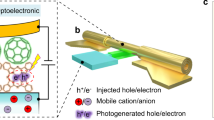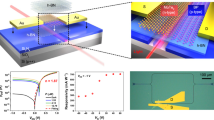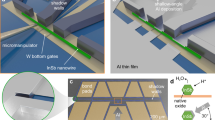Abstract
Recent progress in silicon photonics1,2,3,4,5,6,7,8 has dramatically advanced the possible realization of heterogeneous logic circuits9,10. A variety of Boolean optoelectronic circuits have been proposed11,12,13,14,15. In this context, experimental investigation of logic operations with both optical and electrical inputs in chip-integrable devices is highly desirable. Here, we present a new kind of photodiode-based logic device using scalable heterojunctions of carbon nanotubes and silicon, the output currents of which can be manipulated completely by both optical and electrical inputs. This provides a novel platform for heterogeneous optoelectronic logic elements with voltage-switchable photocurrent responsivity of >1 A W−1, photovoltage responsivity of >1 × 105 V W−1, electrical on/off ratios of >1 × 105 and optical on/off ratios of >1 × 104. To demonstrate their scalability, we fabricated a large array of photoactive elements on a centimetre-scale wafer. We also present bidirectional phototransistors and novel clock-triggerable logic elements such as a mixed optoelectronic AND gate, a 2-bit optoelectronic ADDER/OR gate and a 4-bit optoelectronic digital-to-analog converter.
This is a preview of subscription content, access via your institution
Access options
Subscribe to this journal
Receive 12 print issues and online access
$209.00 per year
only $17.42 per issue
Buy this article
- Purchase on Springer Link
- Instant access to full article PDF
Prices may be subject to local taxes which are calculated during checkout




Similar content being viewed by others
References
Almeida, V. R., Barrios, C. A., Panepucci, R. R. & Lipson, M. All-optical control of light on a silicon chip. Nature 431, 1081–1084 (2004).
Vlasov, Y. A., Bo, X.-Z., Sturm, J. C. & Norris, D. J. On-chip natural assembly of silicon photonic bandgap crystals. Nature 414, 289–293 (2001).
Vlasov, Y. A., O'Boyle, M., Hamann, H. F. & McNab, S. J. Active control of slow light on a chip with photonic crystal waveguides. Nature 438, 65–69 (2005).
Liu, L. et al. An ultra-small, low-power, all-optical flip-flop memory on a silicon chip. Nature Photon. 4, 182–187 (2010).
Rong, H. et al. A continuous-wave Raman silicon laser. Nature 433, 725–728 (2005).
Hofmann, W. H., Moser, P. & Bimberg, D. Energy-Efficient VCSELs for interconnects. IEEE Photon. J. 4, 652–656 (2012).
Michel, J., Liu, J. & Kimerling, L. C. High-performance Ge-on-Si photodetectors. Nature Photon. 4, 527–534 (2010).
Bogaerts, W. et al. Silicon-on-insulator spectral filters fabricated with CMOS technology. IEEE J. Sel. Top. Quantum Electron. 16, 33–44 (2010).
Liang, D., Roelkens, G., Baets, R. & Bowers, J. E. Hybrid integrated platforms for silicon photonics. Materials 3, 1782–1802 (2010).
Lee, K.-W. et al. Three-dimensional hybrid integration technology of CMOS, MEMS, and photonics circuits for optoelectronic heterogeneous integrated systems. IEEE Trans. Electron. Dev. 58, 748–757 (2011).
Krasilenko, V. G., Nikolsky, A. I., Lazarev, A. A. & Pavlov, S. N. Design and applications of a family of optoelectronic photocurrent logical elements on the basis of current mirror and comparators. Proc. SPIE 5948, 59481G 10.1117/12.851574(2005).
Krasilenko, V. G., Ogorodnik, K. V., Nikolskyy, A. I. & Dubchak, V. N. Family of optoelectronic photocurrent reconfigurable universal (or multifunctional) logical elements (OPR ULE) on the basis of continuous logic operations (CLO) and current mirrors (CM). Proc. SPIE 8001, 80012Q doi:10.1117/12.894483(2011).
Brackenbury, L. E. M. Optoelectronic differential multiplexer logic based on phototransistors/LEDs and its use in optical systems. IEE Proc. Optoelectron. 141, 401–408 (1994).
Rao, E. S., Satyam, M. & Kishore, K. L. Electro-optical hybrid logic gates. Semicond. Phys. Quantum Electron. Optoelectron. 10, 1740–1742 (2009).
Fetterman, M. R. Design for high-speed optoelectronic Boolean logic. IEEE Photon. Technol. Lett. 21, 72–76 (2007).
Interconnect. CMOS-compatible optical interconnects and I/O, Section 5.3, page 58, in International Technology Roadmap for Semiconductors, 2011 edn; http://www.itrs.net/Links/2011ITRS/2011Chapters/2011Interconnect.pdf
Hofstein, S. & Heiman, F. The silicon insulated-gate field-effect transistor. Proc. IEEE 51, 1190–1202 (1963).
Bertrand, G. et al. Towards the limits of conventional MOSFETs: case of sub 30 nm NMOS devices. Solid-State Electron. 48, 505–509 (2004).
Stegeman, G., Hagan, D. & Torner, L. χ(2) cascading phenomena and their applications to all-optical signal processing, mode-locking, pulse compression and solitons. Opt. Quantum Electron. 28, 1691–1740 (1996).
Weis, S. et al. Optomechanically induced transparency. Science 330, 1520–1523 (2010).
Jaber-Ansari, L. et al. Mechanism of very large scale assembly of SWNTs in template guided fluidic assembly process. J. Am. Chem. Soc. 131, 804–808 (2009).
Xiong, X., Jaberansari, L., Hahm, M. G., Busnaina, A. & Jung, Y. J. Building highly organized single‐walled‐carbon‐nanotube networks using template‐guided fluidic assembly. Small 3, 2006–2010 (2007).
Kim, Y. L. et al. Highly aligned scalable platinum-decorated single-wall carbon nanotube arrays for nanoscale electrical interconnects. ACS Nano 3, 2818–2826 (2009).
Jia, Y. et al. Achieving high efficiency silicon–carbon nanotube heterojunction solar cells by acid doping. Nano Lett. 11, 1901–1905 (2011).
Wadhwa, P., Seol, G., Petterson, M. K., Guo, J. & Rinzler, A. G. Electrolyte-induced inversion layer Schottky junction solar cells. Nano Lett. 11, 2419–2423 (2011).
Behnam, A. et al. Experimental characterization of single-walled carbon nanotube film–Si Schottky contacts using metal–semiconductor–metal structures. Appl. Phys. Lett. 92, 243116 (2008).
Sze, S. M. & Ng, K. K. Physics of Semiconductor Devices (Wiley-Interscience, 2006).
Seidel, R. W. et al. High-current nanotube transistors. Nano Lett. 4, 831–834 (2004).
Wen, J. et al. High-sensitivity photovoltage based on the interfacial photoelectric effect in the SrTiO3−δ/Si heterojunction. Sci. China Phys. Mech. Astron. 53, 2080–2083 (2010).
Wang, J., Hu, J., Becla, P., Agarwal, A. M. & Kimerling, L. C. Resonant-cavity-enhanced mid-infrared photodetector on a silicon platform. Opt. Express 18, 12890–12896 (2010).
Acknowledgements
This experimental part of this project was mainly supported by a National Science Foundation (NSF) grant (award no. Division of Electrical, Communication and Cyber-Systems (ECCS)-1202376) and an NEU internal seed grant. Y.J.J. acknowledges partial support by NSF-Civil, Mechanical and Manufacturing Innovation (CMMI) (0927088). Y.K.K. and S.P. acknowledge financial support from the National Research Foundation of Korea (grants nos 2011-0002456 and 2012-0005146). A portion of the computational work was carried out using the resources of the KISTI Supercomputing Center (KSC-2012-C2-72 and KSC-2013-C2-024). Parts of the devices were fabricated at the Kostas Nanomanufacturing Center at NEU.
Author information
Authors and Affiliations
Contributions
Y.L.K., Y.J.J. and S.K. initiated the project and conceived the experiments. Y.L.K. fabricated and characterized the devices and analysed the data. H.Y.J. performed measurements and data analysis. B.L. fabricated devices and F.L. assisted with the optoelectronic measurement set-up. J.H. fabricated some of the devices in the final stages of the work. S.K. supervised the study with Y.-K.K. and Y.J.J. S.P. and Y.-K.K. simulated the results and proposed the device mechanism with S.K. All authors contributed to the analysis and commented on the work.
Corresponding authors
Ethics declarations
Competing interests
At the time of submission, Northeastern University (Boston, USA) and Kyung Hee University (Seoul, Korea) were concurrently processing a patent application (PCT/US2013/60666).
Supplementary information
Supplementary information
Supplementary information (PDF 2078 kb)
Rights and permissions
About this article
Cite this article
Kim, Y., Jung, H., Park, S. et al. Voltage-switchable photocurrents in single-walled carbon nanotube–silicon junctions for analog and digital optoelectronics. Nature Photon 8, 239–243 (2014). https://doi.org/10.1038/nphoton.2014.1
Received:
Accepted:
Published:
Issue Date:
DOI: https://doi.org/10.1038/nphoton.2014.1
This article is cited by
-
On-chip optoelectronic logic gates operating in the telecom band
Nature Photonics (2024)
-
Memory phototransistors based on exponential-association photoelectric conversion law
Nature Communications (2019)
-
Optically switchable organic light-emitting transistors
Nature Nanotechnology (2019)
-
Carbon nanotube-based three-dimensional monolithic optoelectronic integrated system
Nature Communications (2017)
-
Deep blue energy harvest photovoltaic switching by heptazole-based organic Schottky diode circuits
NPG Asia Materials (2016)



